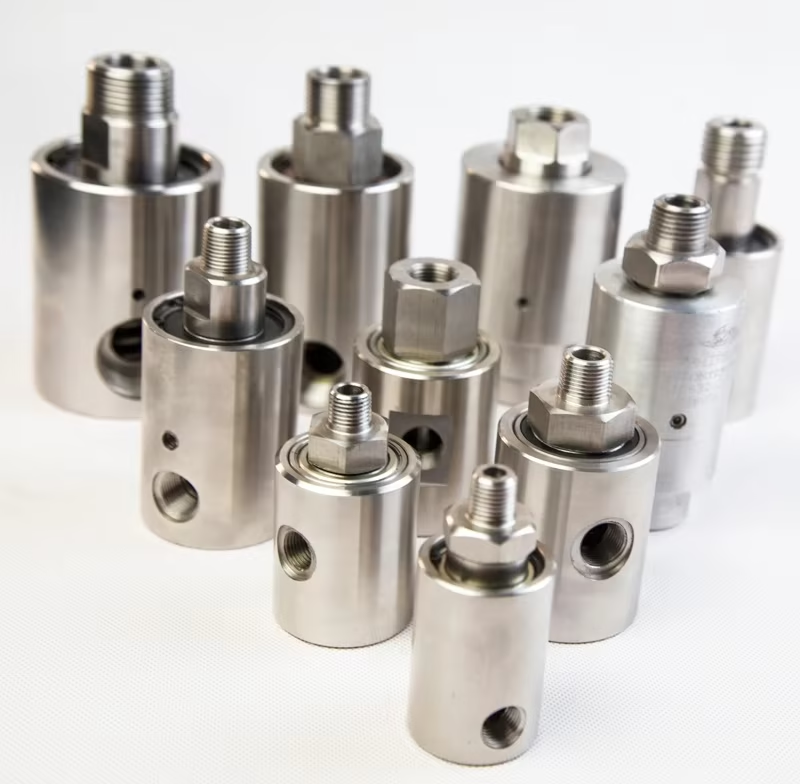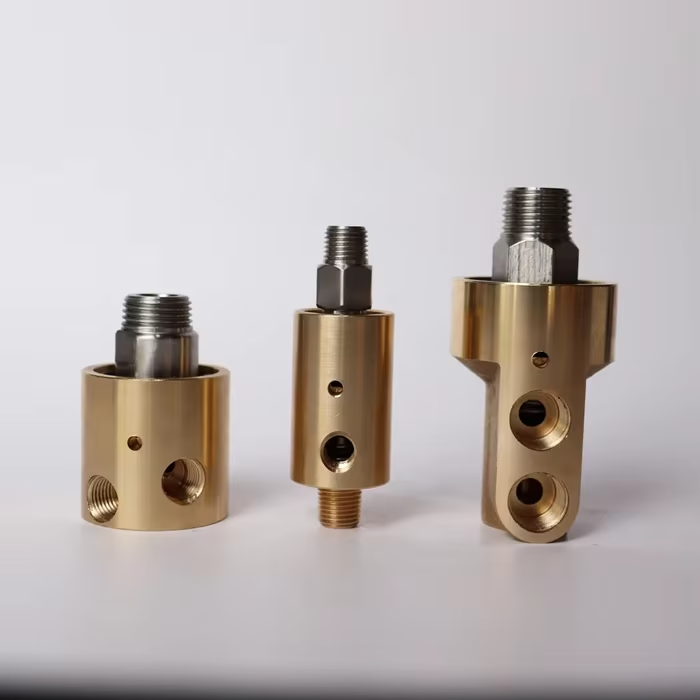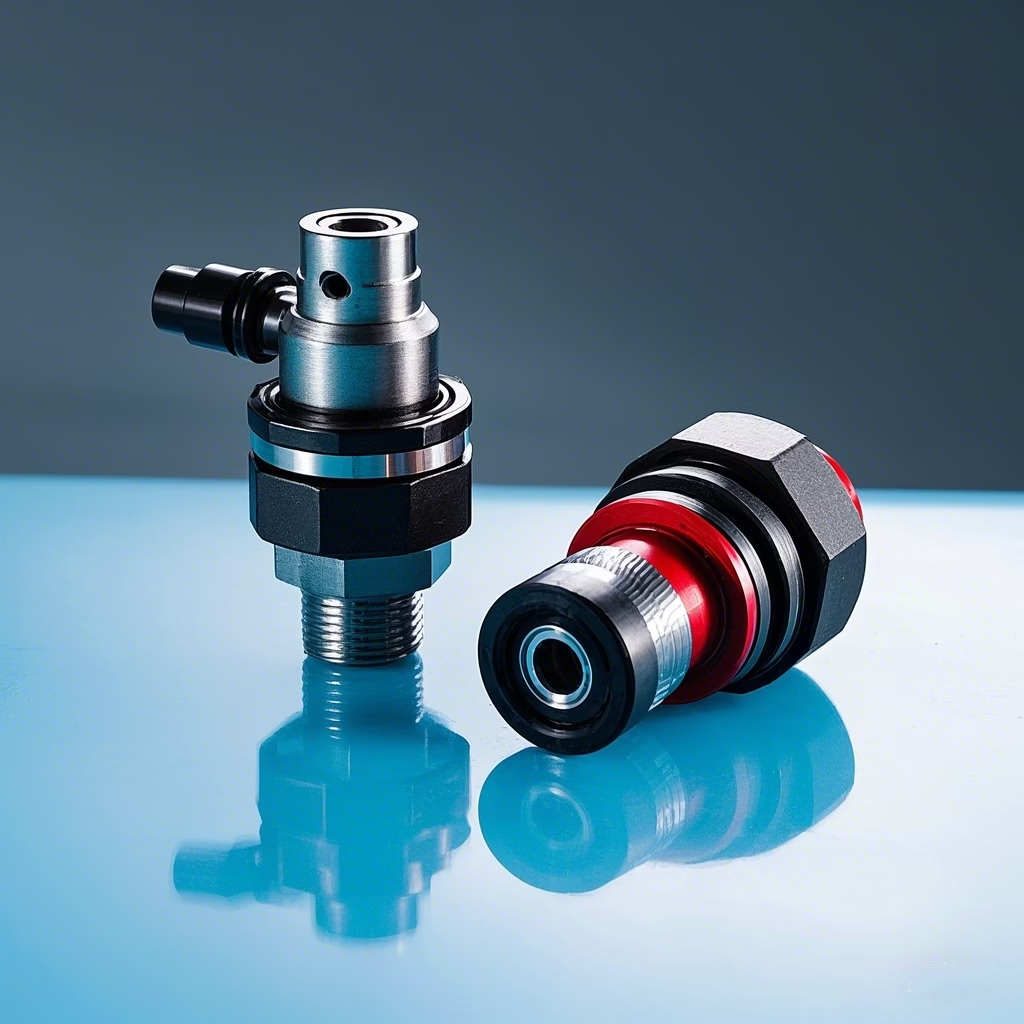What is the difference between a hydraulic rotary union and a swivel joint?
In the world of fluid and gas transfer systems, hydraulic rotary union and swivel joint plays pivotal roles. Both of these components allow for the smooth and efficient transmission of media from a stationary part to a rotating or moving part of the machinery. While they may seem similar in function, hydraulic rotary unions and swivel joints have distinct characteristics, uses, and operational mechanisms. Understanding these differences can help engineers and maintenance professionals select the right component for their specific needs.
In this article, we will compare hydraulic rotary unions and swivel joints in-depth, exploring their design, application, materials, and performance factors. We will also highlight the benefits and limitations of each type, providing a clearer picture for industries involved in fluid handling, automation, and heavy machinery.
1. Hydraulic Rotary Union Overview
What is a Hydraulic Rotary Union?
A hydraulic rotary union (also known as a rotary joint) enables the transfer of hydraulic fluid or other media between stationary systems and rotating components, ensuring leak-free performance even under high pressure and continuous rotation.
 Key Features
Key Features
🛡️ Sealing Mechanism: High-performance seals for reliable, leak-proof rotation.
⚙️ Applications: Widely used in robotics, CNC machines, and hydraulic equipment.
🛠️ Material Options: Stainless steel, brass, and corrosion-resistant alloys.
🔀 Multi-Port Design: Supports multiple media channels (oil, air, coolant).
💪 High-Pressure Resistance: Can handle pressures exceeding 10,000 PSI.
🔩 Precision Sealing: Mechanical face seals, O-rings for long-term reliability.
✨ Customizable: Various materials and configurations to meet specific needs.
How It Works
A stationary housing connects to the fluid supply, while the rotating shaft spins with the machinery.
🔄 Seals maintain a leak-free environment, enabling safe, efficient fluid transfer during rotation.
2. Swivel Joint Overview
What is a Swivel Joint?
A swivel joint is a mechanical connector that allows rotational movement between connected pipes or hoses while maintaining a sealed fluid, gas, or air transfer.
👉 Typically used in lower-pressure systems than hydraulic rotary unions.
Key Features
🔄 Flexibility: Absorbs angular misalignment, enables free rotation without leakage.
⚙️ Applications: Widely used in hose reels, hydraulic cranes, and pressure washing systems.
🛠️ Material Options: Aluminum, stainless steel, or carbon steel for various environments.
🔗 Single-Port Design: Usually supports one fluid passage.
💧 Lower Pressure Capacity: Handles pressures up to 1,000 PSI.
🔧 Basic Sealing: Simple rubber gaskets; may require regular maintenance.
💰 Cost-Effective: More affordable than hydraulic rotary unions.
How It Works
One end of the swivel joint connects to a stationary pipe, and the other to a rotating hose or arm.
The pivot mechanism allows smooth rotation while ensuring the fluid remains sealed inside.
Key Differences Between Hydraulic Rotary Union and Swivel Joint
1. Design and Construction
🔧 Rotary Union Design (High-Pressure Systems)
Sealing Mechanism:
✅ Dual balanced seals (e.g., carbon–silicon carbide pairs)
✅ Example: HS-GF union uses CNC-machined seals with ≤Ra 0.4μm surface roughness for zero leakage
Bearings:
✅ High-precision bearings (ABEC-5 / NSK)
✅ Smooth rotation up to 1,000 RPM with minimal friction
Materials:
✅ Stainless steel (316L / 321) or hardened alloys
✅ Corrosion-resistant coatings for marine, chemical, and harsh environments
Internal Structure:
✅ Complex, multi-seal design to handle water, oil, steam, and high pressures efficiently
🔄 Swivel Joint Design (General-Purpose Systems)
Versatility:
✅ Supports multi-channel designs (e.g., dual-path swivel joints)
✅ Example: Simultaneous oil & coolant transfer in CNC machines
Sealing Mechanism:
✅ Uses O-rings, lip seals, or graphite-impregnated seals
✅ Example: QD series handles steam up to 220°C
Materials:
✅ Cast iron, brass, or PTFE-lined bodies
✅ Cost-effective and suitable for low-to-medium pressure applications
Internal Structure:
✅ Simple, flexible design to prevent hose twisting and accommodate angular misalignment
| Feature | Rotary Union | Swivel Joint |
|---|---|---|
| Pressure Resistance | High Pressure | Low to Medium Pressure |
| Seal Type | Dual Balanced, Precision | O-Rings, Lip Seals |
| Speed | Up to 1,000 RPM | Moderate Speed |
| Materials | Stainless Steel, Hardened | Cast Iron, Brass, PTFE |
| Complexity | Complex, Multi-Seal | Simple, Flexible |
| Example Applications | Hydraulic, Steam, Marine | CNC Coolant, Hose Reels |
2. Pressure and Flow Capacity
🔧 Hydraulic Rotary Union
Designed to handle high-pressure applications, hydraulic rotary unions can manage pressures of up to several thousand PSI. They are built to withstand the demands of industrial machinery and systems requiring stable fluid transfer despite rotational movement.
🔄 Swivel Joint
Swivel joints, on the other hand, are designed for lower to moderate-pressure applications. Their primary purpose is to provide rotation and flexibility to piping systems that do not require the high pressure that hydraulic rotary unions are built to handle.
3. Sealing Mechanism
🔧 Hydraulic Rotary Union
Hydraulic rotary unions use advanced sealing technologies such as lip seals or O-rings, which are specially designed to withstand high pressure and rotating motion without compromising fluid containment.
🔄 Swivel Joint
Swivel joints use a simpler sealing method, such as one or two seals, to prevent leakage during rotation. These seals are typically less sophisticated than those used in hydraulic rotary unions and may not be suitable for high-pressure environments.
4. Applications and Use Cases
🔧 Hydraulic Rotary Union
These are best suited for applications that involve high-pressure hydraulic fluids and require constant rotation, such as industrial machinery, manufacturing, and robotics.
- Heavy Equipment (Excavators/Cranes): Rotary Unions: Enable infinite slewing in excavators through central hydraulic swivel.
- Manufacturing Systems: Rotary unions cool rotating dies in plastic injection molding.
- Energy Sector: Rotary unions in wind turbine hydraulic pitch systems.
🔄 Swivel Joint
Swivel joints are more suited to general-purpose applications that require flexible hose or pipe connections that can rotate freely, such as hose reels, hydraulic cranes, and pressure washing systems.
- Heavy Equipment (Excavators/Cranes): Swivel Joints: Provide boom articulation in mobile cranes via multi-axis hoses;
- Manufacturing Systems: Swivel joints power oscillating robotic welders;
- Energy Sector: Swivel joints for offshore fuel loading arms.
5. Durability and Maintenance
🔧 Hydraulic Rotary Union
Due to the high-pressure nature of their applications, hydraulic rotary unions are built for longevity and heavy-duty use. However, they require regular maintenance to check for wear on seals and internal components.
🔄 Swivel Joint
Swivel joints are typically easier to maintain because they are used in less demanding environments. While they still need regular checks for leaks and seal wear, the maintenance requirements are generally lower compared to hydraulic rotary unions.
When to Choose a Hydraulic Rotary Union or Swivel Joint
1. Choosing a Hydraulic Rotary Union
If you are working with high-pressure systems that require consistent fluid or gas transfer despite rotational movement, a hydraulic rotary union is the best choice.
Common applications include hydraulic systems, robotic arms, and CNC machines, where maintaining pressure and fluid flow is critical.
Continuous 360° rotation required;
High-pressure (>3000 PSI) operation;
Multiple fluid circuits are needed.
Precision speed control is critical.
2. Choosing a Swivel Joint
If you are dealing with lower-pressure systems and need a flexible, rotating connection for hoses or pipes, a swivel joint may be a more suitable option.
Applications such as hose reels, low-pressure cranes, and fluid transfer systems benefit from the flexibility and simplicity of swivel joints.
Articulated movement with <300° rotation;
Space constraints limit component size.
Moderate pressure (<2500 PSI) suffices;
Cost sensitivity outweighs performance needs;
Advantages and Disadvantages of Hydraulic Rotary Union and Swivel Joint
1. Hydraulic Rotary Unions
Advantage: Can handle high-pressure environments.
Advanced sealing mechanisms ensure leak-free operation.
Suitable for continuous, high-performance applications.
Disadvantages: More complex and costly to maintain.
It may not be necessary for lower-pressure applications.
2. Swivel Joints
Advantage: Simpler design and easier maintenance.
Less costly than hydraulic rotary unions.
Ideal for applications requiring rotation but not high pressure.
Disadvantages: Limited pressure handling capacity.
Not ideal for systems that require high precision and sealing.
FAQs
Can a swivel joint replace a hydraulic rotary union?
No, swivel joints lack the durability and pressure resistance required for industrial applications.
What causes leaks in hydraulic rotary unions?
Worn seals, misalignment, or excessive pressure are common culprits.
How often should I replace swivel joints?
Depending on usage, replace every 1–3 years or when leaks occur.
Are hydraulic rotary unions waterproof?
Yes, most are designed to handle water and other corrosive fluids.
Can I use a swivel joint in a robot arm?
Only for lightweight, low-pressure tasks; hydraulic rotary unions are better for industrial robots.
Can swivel joints handle continuous rotation like rotary unions?
No. Prolonged 360° rotation in swivel joints causes accelerated seal wear due to asymmetric loading.
What lubrication is recommended for high-speed rotary unions?
Synthetic PAO-based greases with PTFE thickeners provide optimal performance at >500 RPM.
How do temperature extremes affect component choice?
Rotary unions better withstand thermal cycling through their multi-seal designs, while swivel joints may require special elastomers below -20°F.
Conclusion
Hydraulic rotary unions and swivel joints serve distinct purposes in fluid power systems. Hydraulic rotary unions are engineered for high-pressure, high-speed environments, while swivel joints excel in low-risk, low-pressure tasks. By understanding their differences and applications, you can optimize system efficiency and reliability.
This technical comparison equips engineers with the knowledge to optimize hydraulic system designs. By understanding the distinct capabilities of rotary unions and swivel joints, professionals can improve equipment reliability, reduce maintenance costs, and enhance operational safety across industrial applications. As motion control requirements evolve, selecting the appropriate rotational interface remains critical for achieving peak hydraulic system performance.
While hydraulic rotary unions and swivel joints serve similar functions in terms of allowing rotation and fluid transfer, they differ significantly in terms of pressure capacity, application suitability, and design complexity. Hydraulic rotary unions are built for high-pressure, high-performance environments, whereas swivel joints are ideal for more flexible, low to moderate-pressure applications. By understanding the specific requirements of your system, you can choose the right component to ensure efficiency, safety, and reliability in your operations.







